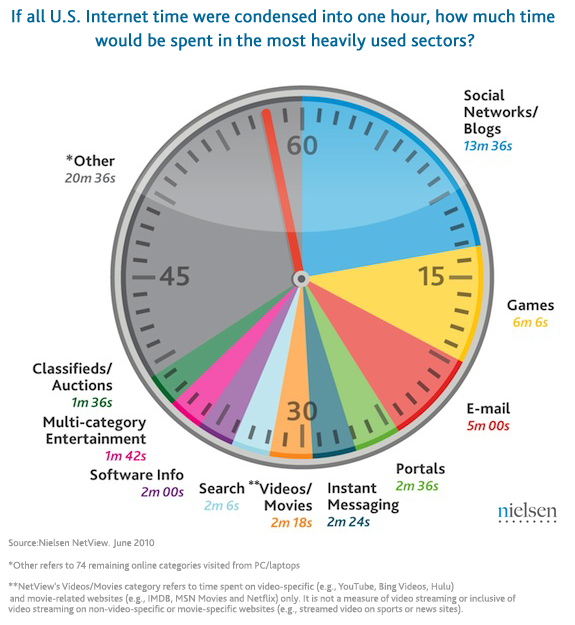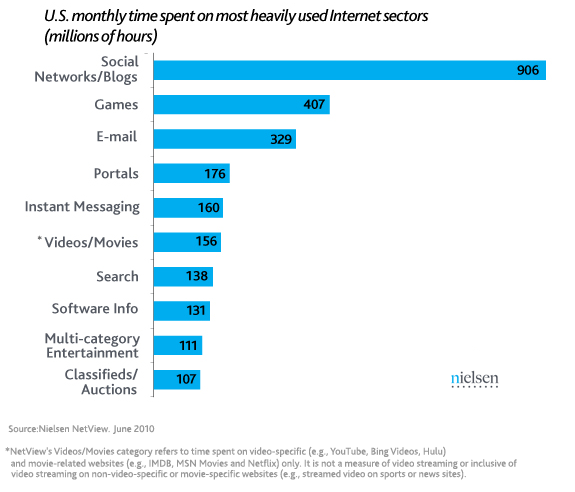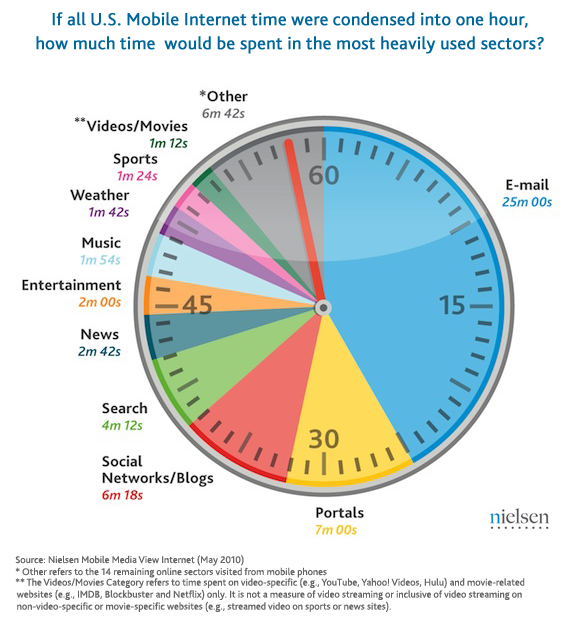Text and graphics updated Aug. 6 to clarify category definitions, timeframe and methodology (see note at bottom)
Americans spend nearly a quarter of their time online on social networking sites and blogs, up from 15.8 percent just a year ago (43 percent increase) according to new research released today from The Nielsen Company. The research revealed that Americans spend a third their online time (36 percent) communicating and networking across social networks, blogs, personal email and instant messaging.
| Top 10 Sectors by Share of U.S. Internet Time | ||||
|---|---|---|---|---|
| RANK | Category | Share of Time June 2010 |
Share of Time June 2009 |
% Change in Share of Time |
| 1 | Social Networks | 22.7% | 15.8% | 43% |
| 2 | Online Games | 10.2% | 9.3% | 10% |
| 3 | 8.3% | 11.5% | -28% | |
| 4 | Portals | 4.4% | 5.5% | -19% |
| 5 | Instant Messaging | 4.0% | 4.7% | -15% |
| 6 | Videos/Movies** | 3.9% | 3.5% | 12% |
| 7 | Search | 3.5% | 3.4% | 1% |
| 8 | Software Manufacturers | 3.3% | 3.3% | 0% |
| 9 | Multi-category Entertainment | 2.8% | 3.0% | -7% |
| 10 | Classifieds/Auctions | 2.7% | 2.7% | -2% |
| Other* | 34.3% | 37.3% | -8% | |
| Source:Nielsen NetView – June 2009-June 2010 *Other refers to 74 remaining online categories visited from PC/laptops **NetView’s Videos/Movies category refers to time spent on video-specific (e.g., YouTube, Bing Videos, Hulu) and movie-related websites (e.g., IMDB, MSN Movies and Netflix) only. It is not a measure of video streaming or inclusive of video streaming on non-video-specific or movie-specific websites (e.g., streamed video on sports or news sites). |
“Despite the almost unlimited nature of what you can do on the web, 40 percent of U.S. online time is spent on just three activities – social networking, playing games and emailing leaving a whole lot of other sectors fighting for a declining share of the online pie,” said Nielsen analyst Dave Martin.


Additional findings include:
- Online games overtook personal email to become the second most heavily used activity behind social networks – accounting for 10 percent of all U.S. Internet time. Email dropped from 11.5 percent of time to 8.3 percent. (Source: Nielsen NetView)
- Of the most heavily-used sectors, Videos/Movies (which includes video-specific and movie-related websites only – and is not inclusive of video streaming behavior elsewhere) was the only other to experience a significant growth in share of U.S. activity online. Its share of activity grew relatively by 12 percent from 3.5 to 3.9 percent. (Source: Nielsen NetView)
- June 2010 was a major milestone for U.S. online video as the number of videos streamed passed the 10 billion mark. The average American consumer streaming online video spent 3 hours 15 minutes doing so during the month. (Source: Nielsen VideoCensus)
- Despite some predictions otherwise, the rise of social networking hasn’t pushed email and instant messaging into obscurity just yet. Although both saw double-digit declines in share of time, email remains as the third heaviest activity online (8.3 percent share of time) while instant messaging is fifth, accounting for four percent of Americans online time. (Source: Nielsen NetView)
- Although the major portals also experienced a double digit decline in share, they remained as the fourth heaviest activity, accounting for 4.4 percent of U.S. time online. (Source: Nielsen NetView)
Email Remains Top on Mobile Internet Activities
The way U.S. consumers spend their Internet time on their mobile phones paints a slightly different picture to that of Internet use from computers. In a Nielsen survey of mobile web users, there is a double-digit (28 percent) rise in the prevalence of social networking behavior, but the dominance of email activity on mobile devices continue with an increase from 37.4 percent to 41.6 percent of U.S. mobile Internet time.

Portals remain as the second heaviest activity on mobile Internet (11.6 percent share of time), despite their double digit decline and social networking’s rise to account for 10.5 percent share means the gap is much smaller than a year ago (14.3 percent vs. 8.3 percent).
Other mobile Internet activities seeing significant growth include music and video/movies, both seeing 20 percent plus increases in share of activity year over year. As these destinations gain share, it’s at the cost of other content consumption – both news/current events and sports destinations saw more than a 20 percent drop in share of U.S. mobile Internet time.
“Although we see similar characteristics amongst PC and mobile internet use, the way their activity is allocated is still pretty contrasting, added Martin. While convergence will continue, the unique characteristics of computers and mobiles, both in their features and when and where they are used mean that mobile Internet behavior mirroring its PC counterpart is still some way off.”
NOTE: This piece of research looked at the share of all U.S. Internet time each of the 84 “standard” NetView subcategories/sectors holds. Only the top 10 sectors were actually called out, the remaining 74 were grouped into “other” and not called out.
The Mobile Internet data is derived from a survey which tracks self-reported mobile internet usage from over 5,000 respondents each month. Mobile internet universe is defined as people that they have used the mobile internet, email or instant messaging on their mobile phone in the past 30 days. The Mobile internet data is weighted back to benchmarks for age, gender, income, race/ethnicity and operator share collected in Mobile Insights.



